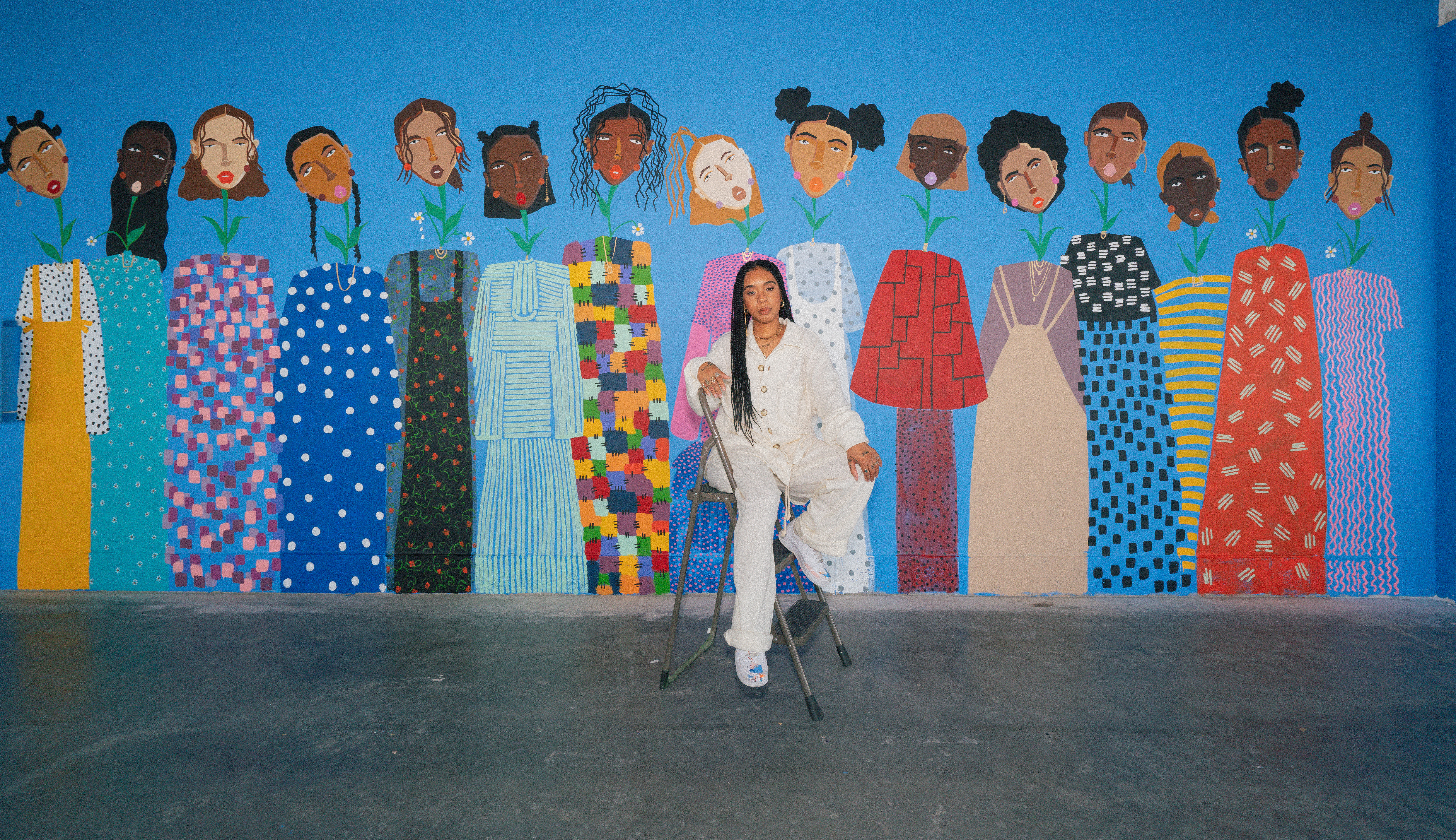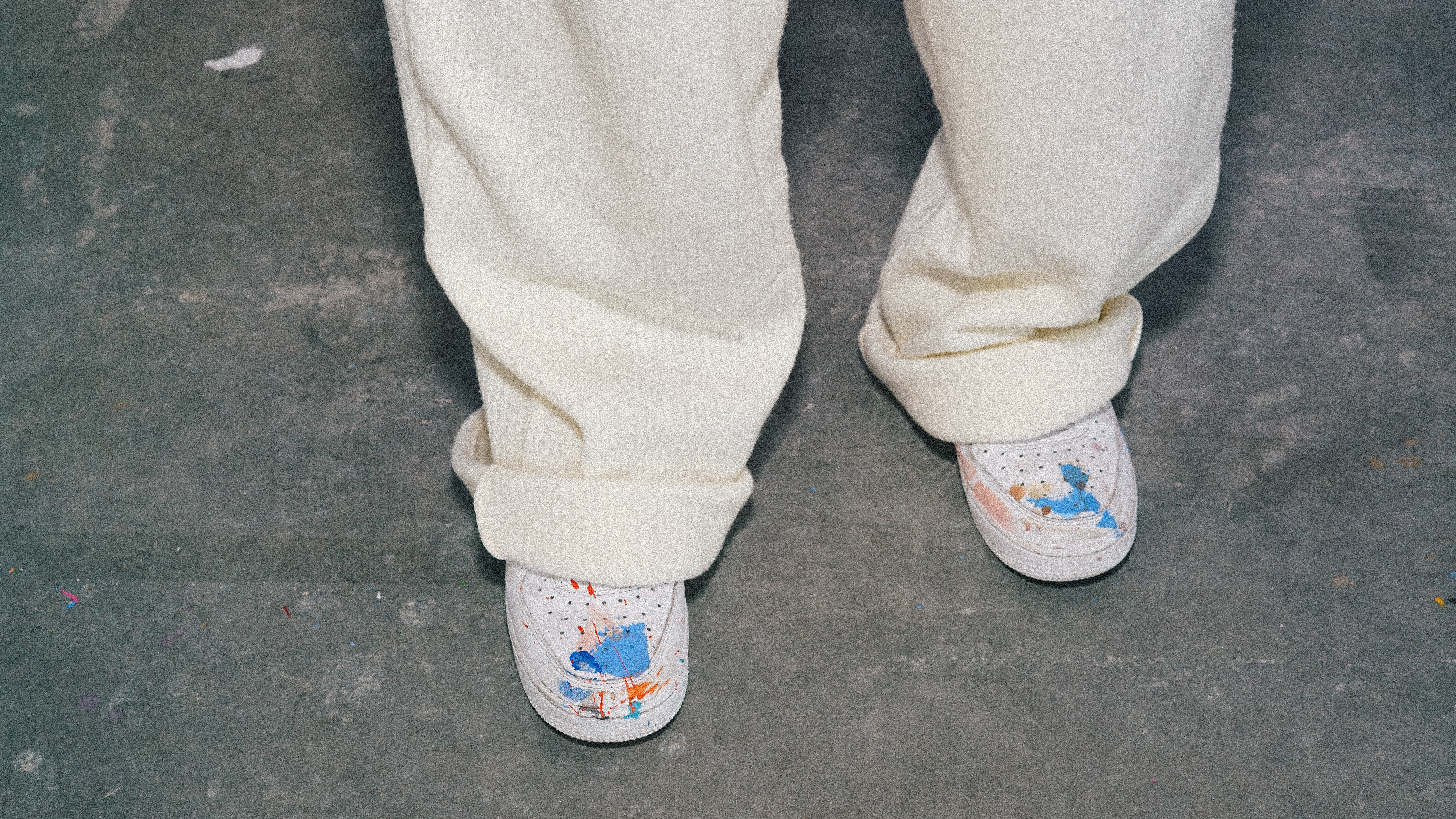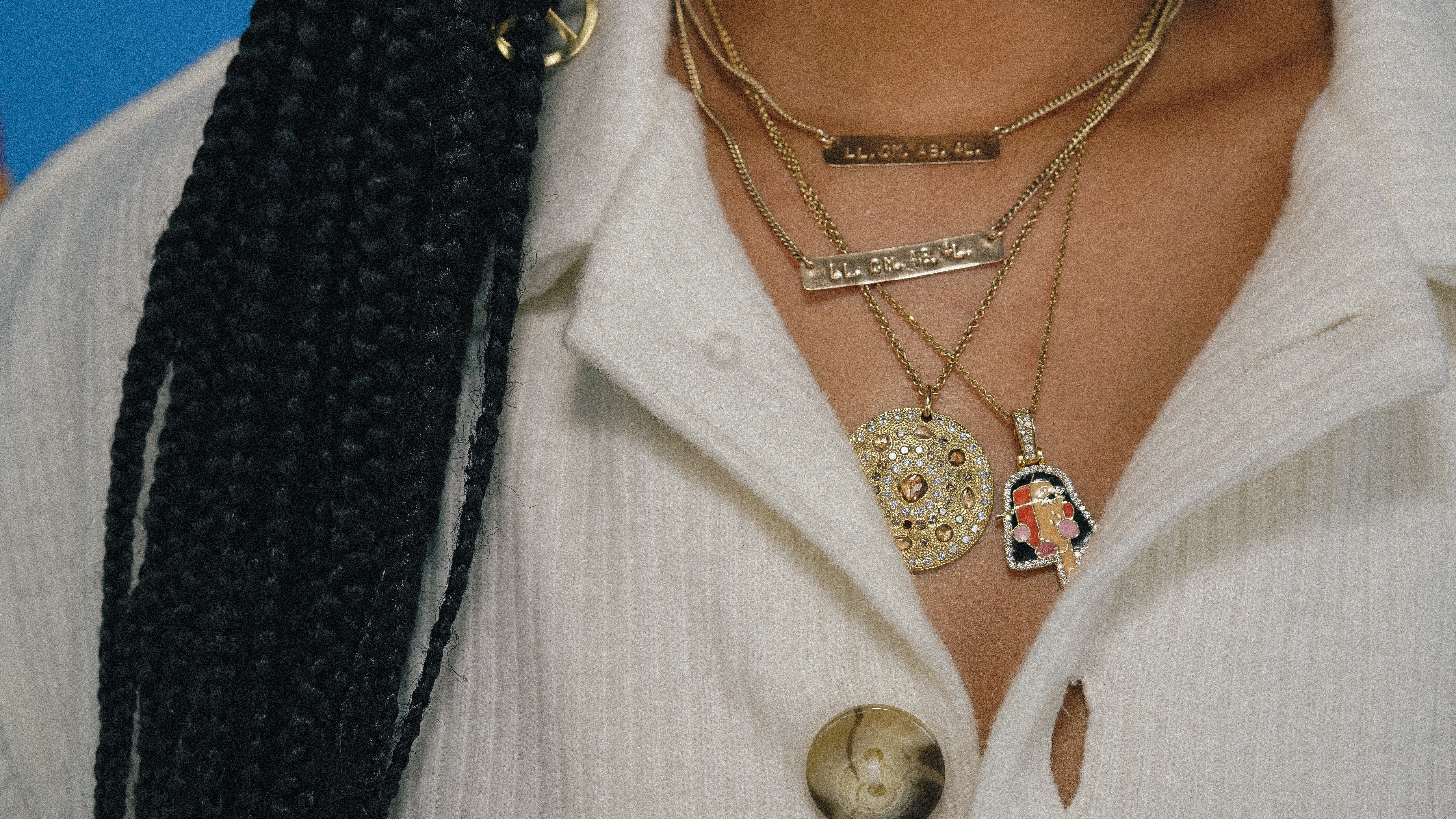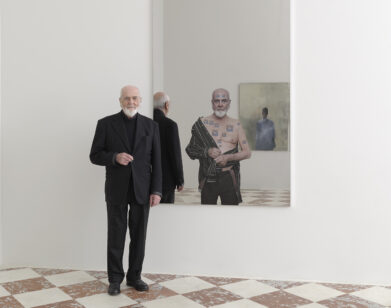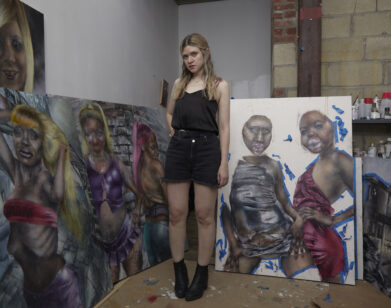A Very Personal (and Socially Distanced) Conversation With the Artist Cristina Martinez
There are plenty of words in the dictionary to describe the art created by a woman whose power radiates from within. For Cristina Martinez, a Black-Mexican artist from Seattle, that word is ‘necessary.’ The 33-year-old mother and former fashion student was recently in the city finishing her 52-foot-long mural titled The Roots inside 3 World Trade Center. Martinez joins a handful of other artists who all create art centered around female empowerment—a topic she knows a thing or two about.
She grew up looking up to a 15-year-old Mexican mother and idolizing the art of Frida Kahlo; that Martinez’s art is inherently feminine, resilient, and loud is no coincidence. The artist’s paintings and illustrations are a map of her lived experiences in the United States, and the world, as a Black and Mexican woman. Now, having found and continuously diversifying following, which includes H.E.R. and Ciara, Martinez is taking her art to new and high terrains in order to share the many stories she carries with her. “All of my experiences in the world being a Mexican woman, being a Black woman, I know that I have to fight a little bit harder to be heard,” she says of the mural. “This is my chance to just put us all out there.” On a humid post-rainy day in Manhattan, I met Martinez on the 79th floor of 3 WTC (all Covid-19 precautions taken into account) as she applied the finishing touches on the mural. High above the humming city streets—sadly the city no longer bustles—we discussed, among other things, her journey in the art world, how Kahlo has guided her life, and the importance of Black and Brown bodies inside the mighty sky towers of New York City—and the world.
———
ERNESTO MACIAS: Tell me about your journey with art, and what brought you here today to this mural.
CRISTINA MARTINEZ: Ever since I was younger I always felt this urgency to express myself. I didn’t always understand how. Sometimes I would write, sometimes I would draw. It didn’t always come in the form of painting, but the creative expression was definitely always there. I always talk about Bob Ross. I love Bob Ross so much. Being younger and seeing him painting on TV— knowing that that’s his job. It always seemed so far away, “God, how did he get to that space?” To be here now, and this is what I do is really crazy to me. I studied fashion for a little while, and I thought that that was the direction that I wanted to go in.
MACIAS: Where did you study?
MARTINEZ: At the Academy of Art in San Francisco. I loved it, and I do still love to sew now. I would spend so much time illustrating my garments and creating this whole person. I was always more drawn to the story than to actually the construction of the piece. It was in fashion school that I really was just starting to realize that I’m a painter. I’m not a fashion brand.
MACIAS: How long did it take you to realize that?
MARTINEZ: I would say I didn’t fully accept it at first. You’re in school, you paid all this money, you’re working so hard, but I finally just left school. I started trying to paint the ideas that were in my mind rather than referencing things. You reference so much in fashion school. I was just like, I wanted to do the complete opposite. I just wanted to tell the stories that were in my mind and it just started to develop. And now we’re here.
MACIAS: We’re here on the 79th floor of this building. You’ve mentioned a little bit that there are 30 something figures here, but tell me what this mural is and what it represents to you. What is it that you’re painting on this wall?
MARTINEZ: When I first thought of the World Trade Center, I’m like, “Perseverance, pushing through.” Buildings were down to nothing and now here they are. That whole idea of not being stopped, and continuing to push through, and to grow again, to bloom again after you’re at your lowest point was the main idea in my mind when I first started to think about what I was going to put on this wall. Being on a floor where I’m surrounded by other art that’s all about female empowerment, that really is a story I tell in my work a lot. I kind of merged those ideas together. In my artwork, I usually focus on telling stories of people that have to work a little bit harder to be heard. So right now, in the state of the world that we’re in, having an opportunity to have this big of a space, to tell a story, I really wanted to focus on Black and brown women. So that’s what I did.
MACIAS: I was thinking on the way here because one of my very first internships was literally down the street by the water. As a person of color, you see these buildings, and sometimes when you walk inside them, there’s not many of us here. I was thinking about that extra layer of the meaning of so many bodies of color on this wall, which may not be the reality. How do you feel about that?
MARTINEZ: To me, it’s one of those things that I feel is so necessary. We are here, we have experiences, and we have stories. We belong in these spaces too. I’ve made it my mission to use every opportunity that I have to make sure that there are faces that look like me, and my cousins, and my friends, and to be seen with a spotlight like this as well. Even when people walk through here, I know it’s different. I think that initially, it might be, “Whoa, what’s going on over there?” It’s an everyday reminder. We are here. We influence so much of culture. I’m Mexican and Black, I was raised by the Mexican side of my family. And all of my experiences in the world being a Black woman, being a Mexican woman, I incorporate that in all of my work. I know that I have to fight a little bit harder to be heard. This is my chance to just put us all out there.
MACIAS: We talked about the personal meaning of this, and we talked about making people uncomfortable with something that is new. So what do you hope that people that aren’t of color, that aren’t Black, what do you hope they take away from it? What is the hope for this mural?
MARTINEZ: I hope that my audience looks at this mural and 1) understands. I just hope that it encourages them to want to hear these stories. To want to put themselves in someone else’s shoes. Lately, I will say, normally if I did a painting that was all Black women, I sell to Black men and women, but lately, the diversity and the people that are collecting my art has grown so much. That is very inspiring to me. As I said, people have walked through here, and I can tell they’re looking, but to just take a minute, and to sit with it, and to understand why it’s necessary and why it is important—and why it’s in your face. There’s a very heavy Black and brown presence, and not just to look at it and just see that, but to understand it and why that’s a big deal in this space.
MACIAS: I’m going to ask you these light questions to get to know you a little better. Do you believe in astrology? And if so, what’s your zodiac sign?
MARTINEZ: I have tried for so long to not believe in astrology, because I’m like, “I love god, but I believe that the sun has the ability to burn our skin, and the sun is so far from us. That’s crazy to me. So to think that we’re not affected by the placement of the planets, and the stars, and the moons, it seems impossible for us not to be. So now I’ve grown to really believe. Every Capricorn I’ve met, and I am a Capricorn, is like an OCD, very extra, very driven, does-too-much kind of person. So I can’t really deny it anymore.
MACIAS: Are you a morning or a night person?
MARTINEZ: I’m a morning person.
MACIAS: What does a typical morning look like for you?
MARTINEZ: I usually wake up at 5:00 a.m. I have a 10-year-old and a 5-year-old, so I make time to have my own time in the morning. They usually are up by 8:00, so before breakfast, I’ve already drawn Beyonce three times. I get a lot done early in the mornings. Waking up here has been no problem really, just because it’s I’ve been up at 8 a.m. here every day from the sunlight. As I’ve gotten older I’ve learned that the resting part of the creative journey is so necessary. You make better art when your body is good. So I do make it a point to sleep.
MACIAS: You went to school for fashion, but do you have any other creative pursuits that you go to?
MARTINEZ: I love to shoot video, I love to take pictures. I document my own creative process a lot. I’ve always really been into that. It’s just like another outlet with no expectations. I can pick up the camera, and it’s something I can learn, and there’s no pressure with it. Also, my boyfriend actually just bought me a typewriter from 1932.
MACIAS: That is so cool.
MARTINEZ: I’m so excited about it. I’m not a writer at all, but I do like to put my thoughts on paper, and I don’t know. People always talk about my Instagram captions, because they are Just whatever my brain is thinking. I write it in that way. And I like to do that. I like to have a physical journal of my thoughts.
MACIAS: You said something, and you said it so casually, but picking up instrument or doing art without any expectation. I think that a lot of artists, a lot of young artists, or creatives in general, are always, in the back of their head, making art with an expectation. How do you get to the point of making art or creating things without that pressure?
MARTINEZ: I’m so glad you asked that. I don’t know if social media has done that or what, but I’ve noticed that people if they want to paint, they feel like they have to be a painter. I try not to even identify. Just creatively I just try to flow, because it gets weird. If you feel the need in yourself to express something, the means to do that are limitless. The most important thing to me is to break down that wall to be able to be vulnerable in a creative way. That’s all people should really focus on. The expectations that we have of ourselves, it’s just not necessary. Not in that way. It’s supposed to bring peace. Making art should bring peace. Worry about making money from it and all that later. First, just connect with art.
MACIAS: You know especially because all that’s happened in the world and in our country lately, I think that art—I live in Brooklyn. I just moved to this new neighborhood. The graffiti, even though the street is covered with All Black Lives Matter, and I’ve seen art in New York before, I don’t know that I’ve seen art, in my lifetime, used as a revolutionary tool to express emotions. I think that people are getting to that point where they’re just letting it out.
MARTINEZ: I think that more often than not when you have a quiet moment, I believe that there’s a creative in everybody, and maybe your outlet for it is different, but that need to create is there. You just have to fuel it. When we have these limitations, especially with COVID, being in our homes, the amount of people that I’ve seen turn to art is so crazy and inspiring because it just shows that the power of art is there. You just have to really tap into it.
MACIAS: Who are some people that inspire you the most?
MARTINEZ: I would definitely say creative Frida Kahlo. I have loved Frida my entire life. Again, with her, the most inspirational thing about her for me is just her entire life was about facing challenge, after challenge, and she continued to turn to her art. I keep that with me all the time. I don’t even feel comfortable saying, “Oh, I’m not inspired right now.” Because to me it’s just an excuse. Being able to turn to my art, no matter what I’m facing has come from her.
Outside of that, my kids and the way that they see the world is very inspiring. I was just telling my mom the other day that my daughter was like, “I’ll see you again when the sky is blue and the clouds are out,” but she’s really just trying to say, “I’ll see you tomorrow.” It’s a painting in my head.
MACIAS: Even when you don’t know someone, but you recognize references, it’s like you already know them. What would you be doing if you weren’t creating art or an artist?
MARTINEZ: I always say the two things I care about the most are being a really great artist and a really great mom. I would probably have 10 kids. If it wasn’t for my art, I would probably have, literally, 10 or 15 children.
MACIAS: Well, now you have 40.
MARTINEZ: I love, I love, I love being a mom. I love my kids. I loved that whole experience. The responsibility of taking care of a human, and giving them the tools that they need to go on and do great things. That’s just a blessing.
MACIAS: I didn’t grow up with artist parents, and so I can’t imagine what it’s like.
MARTINEZ: Oh, my kids are crazy.
MACIAS: But when I speak to people that have made a certain mark in life, or whatever, it’s usually they grow up with no limitations, and art is always part of it. So that’s really exciting for your kids.
MARTINEZ: Exactly. My daughter just sold a painting the other day for $1,300. My son has green hair.
MACIAS: See, that is so cool.
MARTINEZ: I’m always like, if I was exposed to art this young, I wonder what I would have been like?
MACIAS: You made it here without being directly exposed. Now imagine. What is your favorite movie?
MARTINEZ: Spanglish. I’ve watched Spanglish so many times. I can relate to that movie so much because of the way I grew up. Every time I just need something on, I watch that movie.
MACIAS: I love that. You reminded me of it. I forget about it.
MARTINEZ: And the girl’s name is Cristina, too.
MACIAS: It’s such a weird cast, and it worked. What books are you reading, or what’s the last book that you read?
MARTINEZ: I read a lot of books. I read a lot of fiction books because I liked to just not think about anything for a while. The last book that I read was probably Little Fires Everywhere. I read it again so I could watch the show. Very triggering, but really good.
MACIAS: All those shows that that group of women have been creating—
MARTINEZ: It’s a lot. I would only let myself watch one episode a day, because it was like, “This is too much. I’m going to absorb all this energy and then be in a bad mood.”
MACIAS: What was the last thing you were embarrassed about?
MARTINEZ: My son just asked me this the other day. Probably sending a text to the wrong person. I’m notorious for that.
MACIAS: What was the last thing you were proud about?
MARTINEZ: This, being here? For sure. I will remember doing this.
MACIAS: I think this is a pretty big deal. What makes you happy?
MARTINEZ: Being a mom for sure. Being in nature, growing up in Seattle, just being outdoors. The sun makes me happy. I’ve learned to really appreciate that stuff, honestly. Being up here, being able to see the sunset, reading books, traveling. I’ve had a rough last few years and being able to find happiness in the smallest things has been key for me lately.
MACIAS: I think that’s a major part of surviving the times right now. Do you have any regrets?
MARTINEZ: I regret not finishing art school. I wish I would have just changed my major rather than being so discouraged by the fact that I knew I wasn’t doing the right thing, because yes, it was in fashion, but it was still art. I don’t think education is for everybody, but for me, sometimes I think that the stories in my mind are so intense that I should have grown my technical skill more. I am doing that on my own just at a different pace. I got so discouraged knowing that this isn’t what I’m supposed to be doing, that I didn’t really stop and think. Now, if I could go back to school right now, I would.
MACIAS: What’s next for you?
MARTINEZ: I’m going to keep making art. I’m continuing to put myself in spaces to have my work seen, mainly, because of the story that I’m telling. If I could completely remove myself from all of it and just tell these stories, it would still be that important to me. This is my way of giving back, fighting for these people that have to fight to be heard, myself included. Really showing people that art can bring peace. I don’t just show the good stuff. It’s a journey, and I’ve been pretty open about my journey artistically and personally. My audience has really seen art heal me in a lot of ways. I encourage people to just use art, to find peace. If everybody just made art the world would be a lot better.

